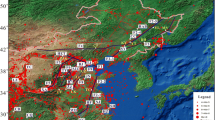Abstract
After the Wenchuan M S 8.0 Earthquake, which occurred on May 12, 2008, in Sichuan Province, China, we conducted a series of hydraulic fracturing stress measurements in three 200 m deep boreholes (ZK01, ZK02, and ZK03) drilled in Beichuan and Jiangyou regions near the northeastern segment of Longmenshan fault belt in 2009. These measurements revealed the near-surface stress field in the fault region one year after the Wenchuan M S 8.0 Earthquake. However, the lack of the stress measurements before the earthquake in the same region makes it difficult to understand variations of the in situ stress field (near-surface) by comparative analysis. In order to determine the unknown horizontal principal stresses before the earthquake in Beichuan and Jiangyou regions, the following research method was tentatively applied. Firstly, we calculate the static co-seismic stress field by linear elastic finite element numerical simulation with ANSYS, based on the co-seismic static displacement generated by the Wenchuan M S 8.0 Earthquake along the central Longmenshan fault plane in Beichuan and Jiangyou. Secondly, combining hydraulic fracturing measurements (after the earthquake) with the co-seismic stress (simulation), the magnitudes and orientations of horizontal principal stresses before the earthquake were calculated. Finally, the variation of the in situ stress (near-surface) in Beichuan and Jinagyou, both before and after the Wenchuan M S 8.0 Earthquake, were obtained by comparative analysis. To do this the magnitude of S Hmax was decreased on average by 13.01 and 6.54 MPa after the earthquake in ZK02 and ZK03, respectively and the magnitude of S Hmin was decreased by 2.54 and 5.29 MPa in ZK02 and ZK03, respectively. Following the earthquake, the average direction of S Hmax rotated anticlockwise by 42.5°.
Similar content being viewed by others
References Cited
An, Q. M., Ding, L. F., Wang, H. Z., 2004. Research of Property and Activity of Longmen Mountain Fault zone. Journal of Geodesy and Geodynamics, 24(2): 115–119 (in Chinese with English Abstract)
Chen, G. H., Xu, X. W., Zheng, R. Z., et al., 2008. Quantitative Analysis of the Co-Seismic Surface Rupture of the 2008 Wenchuan Earthquake, Sichuan, China, along the Beichuan-Yingxiu Fault. Seismology and Geology, 30(3): 723–738 (in Chinese with English Abstract)
Cui, X. F., Hu, X. P., Yu, C. Q., et al., 2010. Research on Focal Mechanism Solutions of Wenchuan Earthquake Sequence. Acta Scientiarum Naturalium Universitatis Pekinensis, 47(6): 1063–1072 (in Chinese with English Abstract)
Feng, C. J., Chen, Q. C., Wu, M. L., et al., 2012. Analysis of Hydraulic Fracturing Stress Measurement Data—Discussion of Methods Frequently Used to Determine Instantaneous Shut-In Pressure. Rock and Soil Mechanics, 33(7): 2149–2159 (in Chinese with English Abstract)
Haimson, B. C., 1978. The Hydrofarcturing Stress Measuring Method and Recent Field Results. Int. J. Rock Mech. Min. Sci. & Geomech. Abstr., 15: 167–178
Haimson, B. C., 1987. Measurement of In Situ Stress. Methods Exp. Phys., 24(Part B): 377–408
Haimson, B. C., 1989. Hydraulic Fracturing Stress Measurements. Int. J. Rock Mech. Min. Sci. & Geomech. Abstr., 26: 647–685
Haimson, B. C., Cornet, F. H., 2003. ISRM Suggested Methods for Rock Stress Estimation-Part 3: Hydraulic Fracturing (HF) and/or Hydraulic Testing of Pre-Existing Fractures (HTPF). Int. J. Rock Mech. Min. Sci. & Geomech. Abstr., 40: 1011–1020
Haimson, B. C., Tunbridge, L. W., Lee, M. Y., et al., 1989. Measurement of Rock Stress Using the Hydraulic Fracturing Method in Cornwall, U. K. Part II. Data Reduction and Stress Calculation. Int. J. Rock Mech. Min. Sci. & Geomech. Abstr., 26(5): 361–372
Hayashi, K., Haimson, B. C., 1991. Characteristics of Shut in Curves in Hydraulic Fracturing Stress Measurements and the Determination of the In Situ Minimum Compressive Stress. J. Geophys. Res., 96: 18311–18321
Hu, X. P., Yu, C. Q., Tai, K., et al., 2008. Focal Mechanism Solutions of Wenchuan Earthquake and Its Strong Aftershocks Obtained from Initial P Wave Polarity Analysis. Chinese J. Geophys., 51(6): 1711–1718 (in Chinese with English Abstract)
Hubbert, M. K., Willis, D. G., 1957. Mechanics of Hydraulic Fracturing. Trans. Aime., 210: 153–166
Kusky, T. M., Abduwasit, Ghulam, A., Wang, L., et al., 2010. Focusing Seismic Energy along Faults through Time-Variable Rupture Modes: Wenchuan Earthquake, China. Journal of Earth Science, 21(6): 910–922
Li, F. Q., Sun, S. Z., Li, L. Q., 1982. In Situ Stress Measurements in North China and Tancheng-Lujiang Fault Zone. Chinese Journal of Rock Mechanics and Engineering, 1(1): 73–86 (in Chinese with English Abstract)
Li, F. Q., Wang, L. J., 1979. Stress Measurements in North China. Acta Geophysica Sinica., 22(1): 1–8 (in Chinese with English Abstract)
Li, H. B., Fu, X. F., Jerome, V. W., et al., 2008. Co-Seismic Surface Rupture and Dextral-Slip Oblique Thrusting of the M S 8.0 Wenchuan Earthquake. Acta Geologica Sinica, 82(12): 1623–1643 (in Chinese with English Abstract)
Li, Y., Huang, R. Q., Zhou, R. J., et al., 2009. Geological Background of Longmenshan Seismic Belt and Surface Ruptures in Wenchuan Earthquake. Journal of Engineering Geology, 17(1): 4–18 (in Chinese with English Abstract)
Liao, C. T., Zhang, C. S., Wu, M. L., et al., 2003. Stress Change near the Kunlun Fault before and after the M S 8.1 Kunlun Earthquake. Geophys. Res. Lett., 30(20): 2027–2030
Wang, L., Tian, W. B., Masoud, A., et al., 2013. Relationship between Remotely Sensed Vegetation Change and Fracture Zones Induced by the 2008 Wenchuan Earthquake, China. Journal of Earth Science, 24(2): 282–296
Xu, X. W., Wen, X. Z., Ye, J. Q., et al., 2008. The M S 8.0 Wenchuan Earthquake Surface Ruptures and Its Seismogenic Structure. Seismology and Geology, 30(3): 597–629 (in Chinese with English Abstract)
Zoback, M. D., Tsukahara, H., Hickman, S., et al., 1980. Stress Measurements at Depth in the Vicinity of the San Andreas Fault: Implications for the Magnitude of Shear Stress at Depth. J. Geophys. Res., 85: 6157–6173
Author information
Authors and Affiliations
Corresponding author
Rights and permissions
About this article
Cite this article
Feng, C., Chen, Q., Tan, C. et al. The stress state of the Beichuan-Jiangyou segment of the Longmenshan fault before and after the Wenchuan M S 8.0 Earthquake. J. Earth Sci. 25, 861–870 (2014). https://doi.org/10.1007/s12583-014-0473-z
Received:
Accepted:
Published:
Issue Date:
DOI: https://doi.org/10.1007/s12583-014-0473-z



